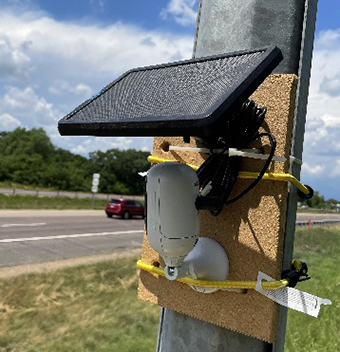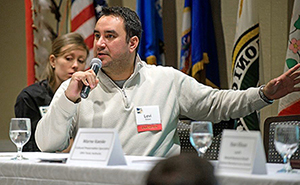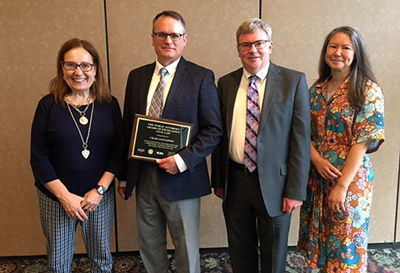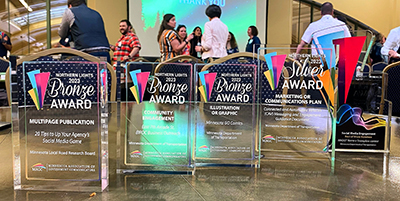 |
|

|
 |
TABLE of CONTENTS
 |
Graduate engineer and land surveyor trainees meet in Duluth |
By Michelle Clark, Career Pathway Programs, Office of Human Resources

Assistant District Engineer Major Projects Pat Huston talked to a group of Grad Trainees about the Twin Ports Interchange project work. Photo by Michelle Clark |
The Graduate Engineer and Land Surveyor program gathered in Duluth from May 22 to May 24 for their annual spring meeting. The trainees learned about the many projects across District 1, including the DNR/Aquatic Organism Passage, drone surveying in the district, work on Hwy 61 in Two Harbors and Grand Marais and planning with WisDOT for the Blatnik Bridge.
On May 23, the participants split into smaller groups to visit the Twin Ports Interchange project in Duluth, a complicated $435 million project. Once complete, TPI will feature a new conventional design and enhance safety by eliminating weaving problems and left exits, improving sightlines on merging lanes and providing a continuous driving lane for motorists on I-35. The project also required updating infrastructure and relocating the Coffee Creek channel into a new, combined Coffee Creek and Miller Creek culvert.
The following day, the 148th Fighter Wing welcomed the grad trainees to their base for a tour and presentation. The group learned more about the mission and the community outreach of the Minnesota Air National Guard unit. Before leaving, the group got an up-close look at the F-16 jets and a soul-shaking flyover pass. |
| |
|

|
 |
TABLE of CONTENTS
 |
Sarah Ghandour joins Office of Transit and Active Transportation as new director |

Sarah Ghandour |
After serving as Transit Section director at Metro District for more than two years, Sarah Ghandour has taken on a new role as director of the Office of Transit and Active Transportation, effective June 7.
Prior to joining MnDOT, Ghandour worked for the Metropolitan Council as the manager of design on the Green Line Extension project. She has also worked as a consultant in the Los Angeles area on various urban design and planning projects.
Ghandour is a certified planner and has a master’s degree in architecture from the Pratt Institute in New York and a bachelor’s degree in architecture from the University of Minnesota. |
| |
|

|
 |
TABLE of CONTENTS
 |
New research projects show importance of collaboration for Office of Research & Innovation |
By Doug Mack

This Inductive Loop Signature Technology was part of a project funded by Research & Innovation. Photo courtesy Office of Research & Innovation
|
Answering big questions, solving challenging problems is done best through convening diverse perspectives. Research is, by nature, collaborative. That’s no different at MnDOT, including the Office of Research & Innovation, which frequently works with partners across the agency and beyond.
One way Research & Innovation does this is by soliciting academic research proposals that respond to the needs of Minnesota transportation practitioners. The program operates on an annual cycle, with funding decisions in December. Research & Innovation funded 28 projects in the last cohort, spanning eight categories ranging from bridges and structures to policy and planning. Projects are led by academic researchers at 16 qualified universities from across the country. A Technical Advisory Panel guides all projects to help ensure success.
A sampling of the most recently funded projects shows the breadth of the program, with project titles including:
- “Understanding Causes of Concrete Culvert Pipe Joint Separation”
- “Mitigating Community Harms of Dense Highway Infrastructure ‘Spaghetti Junctions’”
- “Human-Centered Testing of Rear-Facing Display to Reduce Vehicle Collisions with Snowplows”
- “Improving Safety for People Walking and Biking at Roundabouts”
Funding such projects leads to real-world improvements for transportation across Minnesota and far beyond the state. One example of this comes from a recent project led by University of Minnesota researcher Chen-Fu Liao, which involved investigating the efficacy of a specific kind of technology in classifying vehicles. To understand what kind of traffic is traveling on various roadways, the agency needs to know not just how many vehicles there are but the various kinds — how many cars, how many trucks, how many motorcycles, and so on, as well as the various sizes within each category.
Generating these specific counts is a tricky proposition, and this research tested one possible method, called inductive loop signature technology. The researchers’ work showed that this approach does indeed have significant potential, and the team concluded that “through technology updates and improvements to system data, MnDOT is now confident this is a feasible and cost-effective tool to gather the vehicle classification data it needs.”
To read more about this research project or any others, visit the Research & Innovation website. |
| |
|

|
 |
TABLE of CONTENTS
|
New library materials now available |
By Madeline Kuncio, MnDOT Library
The latest issue of New Library Materials is available. This month’s featured book is “Why Motivating People Doesn't Work...and What Does,” by Susan Fowler. New Library Materials is a compilation of resources added to the library collection during the previous month.
Visit the library website and click on the “Stay Current” tab to sign up for regular updates. Questions and feedback are welcome at Ask a Librarian.
|
|

|
 |
TABLE of CONTENTS
|
On the Job: Levi Brown builds relationships with tribal nations |
By Doug Mack

Levi Brown speaks at a Tribal-State Relations Training session. Photo by Judy Jacobs |
There are 11 different tribal nations within the borders of Minnesota and MnDOT works with all of them on various projects. Levi Brown, who is a member of the Leech Lake Band of Ojibwe, serves as MnDOT’s director of Tribal Affairs and leads much of the communication and coordination between the agency and the tribal governments.
How long have you been at MnDOT and in what positions?
I started in 2018 and I’ve been in this role the whole time.
What are your day-to-day tasks?
I have to measure what projects we have going on statewide and what type of issues or risks we might have in a certain area. And then at the same time, I have to think about what relationships we have in the particular area where we might be working. I also handle communications at a leadership level between the 11 tribal nations and MnDOT leadership, from district engineers all the way up to the Commissioner’s office. I help make sure people don’t talk past each other or misinterpret things.
You’re also involved with the Tribal-State Relations Training classes. Can you give us a summary of those events?
You spend two days learning about the eleven tribal nations that all share a common border with Minnesota and hearing realistic examples of the government-to-government partnerships and conversations that are taking place every day. They also get to meet and hang out with their tribal affairs director, and that connection can be a huge tool when staff are working in Indian Country – they know who’s there to support them.
What are the most challenging and rewarding parts of your job?
The most challenging part has to be that the job is never done. As a director, I often get the difficult projects that can seem like they go on forever. And then, once you're finished with them, there's always another one. But each challenge provides a new opportunity for us to learn and grow, and that's the rewarding part. So it starts with the challenge and on the back end comes that reward. We’ve had some of very difficult situations and we learned from them and on the back end we had a much better understanding. I think that's the biggest reward any state employee could ever ask for.
Part of the reward is also knowing that you've done something that nobody else has ever done, because we do government relations like no other state, no other government entity.
What’s special about the way that Minnesota works with tribal nations?
I think tribal nations throughout the country struggle with being treated as secondly or having folks making decisions for them and then telling them about the decision. They’re not really giving them a chance to engage or to be partners, right? I think at MnDOT, we do a remarkable job of making sure that we always work with tribal nations as a partner who's who genuinely wants input and to work as a partnership and alliance.
Quite often we need to have multiple discussions on things we don't agree on, until we get to a point where it works for both the tribal nation and for MnDOT. That's part of what my office does daily. We make sure that we provide access to the right, level of tribal leadership and that they have access to MnDOT leadership or decision-making staff and they get to be part of that decision.
Is there anything about your job that might surprise other people either inside or outside the agency?
I think if people realized how much dialogue goes on between tribal nation staff and MnDOT staff – not at a leadership level, but at the staff level – they would be quite surprised. In my role, I get to see that, and it’s really humbling to watch our MnDOT staff really excel. We’ve been changing the social norms that have lined tribal relations and non-tribal relations throughout this country’s history, and it just makes me feel so good to see our staff blazing new trails and coming up with new ways of working with tribal nations. I just wish people could see that more often.
Which is what are your interests or hobbies outside of your work?
I’m a volunteer firefighter on my reservation – I’ve been doing that for about 12 years. I’ve coached high school golf for 17 years. I hunt a lot and spend a lot of time in the woods and out on Cass Lake with my family.
To learn more about the tribal-state government-to-government relationships and the Tribal-State Relations Training (which is open to all State of Minnesota employees), visit the Tribal-State Relations Training page on the MnDOT website.
Do you or a co-worker have an interesting job to share with readers? Send us your ideas, and we’ll contact you for more information.
Recent employee profiles:
|
 |
|

|
 |
TABLE of CONTENTS
|
Knock, Knock! Send us your kids' transportation jokes |
By Doug Mack
International Joke Day is coming on July 1 and the social media team in the Office of Communications is looking for some transportation-related humor to post on social media. Specifically, they’re hoping to share some jokes dreamed up by kids. Knock-knock jokes about snowplows, road construction puns, highway one-liners – anything connected to MnDOT, really. It doesn’t even have to make sense (kid jokes often don’t, as any parent can attest).
The social media team will share a few of their favorites on July 1 and, depending on the number of submissions, perhaps more over the course of the summer. Send submissions, along with the jokester kid’s first name and age, to the social media team by June 27.
Jokes that are offensive, political or obviously just copied by parents from a joke book will not be considered. Jokes that are cheesy or confusing, however, are totally fine. |
 |
|

|
 |
TABLE of CONTENTS
|
Craig Gustafson receives Public Attorney Award of Excellence |
By Doug Mack

Office of Chief Counsel employees pose after the award ceremony. From left to right: Beth Sheffer, Craig Gustafson, Jim Cownie and Ericca Erhard. Submitted photo |
MnDOT Chief Counsel Craig Gustafson received the Public Attorney Award of Excellence from the Minnesota State Bar Association at a ceremony on June 2. Deputy Chief Counsel Jim Cownie presented the award, hailing Gustafson as “a great public lawyer and public servant, and also a great boss.”
“Craig’s variety of public lawyer roles really demonstrates his commitment to public service,” Cownie said. “But even more importantly, Craig truly cares about the people who work for him and he works hard to ensure that his team members have challenging and rewarding careers.” |
 |
|

|
 |
TABLE of CONTENTS
|
Minnesota Association of Government Communicators honors MnDOT projects |
By Doug Mack

MnDOT communications and public engagement efforts received five Northern Lights Awards. Photo by Jake Loesch |
MnDOT’s communications efforts were in the spotlight on June 15 as the agency received five Northern Lights Awards from the Minnesota Association of Government Communicators.
“These awards are especially meaningful because they are judged by our peers – fellow government communicators who understand the unique challenges and opportunities of our work,” said Jake Loesch, director of the Office of Communications and Public Engagement
The following MnDOT projects received awards:
- Bronze award for Community Engagement: East 7th/Arcade Street BIPOC Business Outreach (Metro District)
- Bronze award in the Multipage Publication category: 20 Tips to Up Your Agency’s Social Media Game (Research & Innovation / LRRB)
- Bronze award for Illustration/Graphic: Minnesota GO Comics (OTSM/SMTP)
- Silver award for Marketing or Communications plan: CAV Messaging and Engagement Guidance Document (CAV-X)
- Northern Lights award and Best of Show nominee for Social Media Engagement: Name a Snowplow contest
|
 |
|

|
 |
TABLE of CONTENTS
|
Traffic Cam Puzzler #3 |
By Doug Mack
Can you name the place pictured below? The photo is from a traffic camera on the 511 website and app and the satellite view shows its location with the road labels removed.
If you think you know the answer, email Newsline editor Doug Mack. The first three people to submit the correct answer will receive the fame and glory of having their names listed in the next issue of Newsline.
Results from the last Puzzler: The location was Hwy 52 (and Hwy 63) just south of Rochester. More than 40 people submitted answers and nearly all of them were correct. The first three to get it right were Nathan Engman (Metro), Debra Yates (District 7) and Anthony Bale (District 6). Congrats to them and thanks to everyone who played!
|
 |
|
|
|



